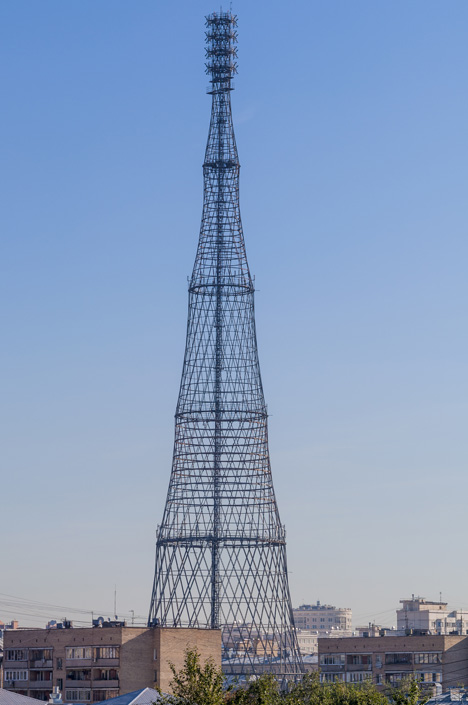Tadao Ando, Rem Koolhaas and Kengo Kuma join fight to save Moscow's Shukhov Tower
News: architects including Tadao Ando, Rem Koolhaas, Kengo Kuma, Thom Mayne and Elizabeth Diller have launched an urgent appeal to Russian president Vladimir Putin to halt demolition of Moscow's iconic Shukhov Radio Tower.
The group is among a host of names from the fields of art, architecture and engineering to have signed an open letter to Putin calling for the preservation of the 160-metre conical steel structure, which was completed by Russian engineer Vladimir Shukhov in 1922 and has been dubbed as the Russian equivalent of the Eiffel Tower.
Written by historian Jean-Louis Cohen and photographer Richard Pare, both experts in Soviet architecture, the letter claims the tower represents "a unique contribution of Russian engineering genius" and "an essential part of Moscow's heritage".
It reads: "The Shabolovka Radio Tower, the largest such structure ever built, remains as Vladimir Shukhov's masterpiece and his monument. It is one of the emblems of Moscow, and one of the superlative engineering feats of the twentieth century, still influencing and enriching technical and architectural ideas globally."

The text also notes that the tower's replacement could take advantage of a planning loophole, allowing it to bypass the city's usual nine-storey height restriction and extend up to 50 storeys, presenting "a golden opportunity for a cynical modern Erostratus".
Other prominent figures to have signed the petition include Tate director Nicholas Serota, Columbia University's Robin Middleton, Canadian Centre for Architecture founder Phyllis Lambert and Royal Academy of Arts curator Kate Goodwin.
The campaign to save the tower was launched following an announcement on 25 February that the Russian State Committee for Television and Radio Broadcasting had agreed to dismantling the steel diagrid, having left it to deteriorate for years.
In 2009 Putin had expressed support for restoring the tower and transforming it into a tourist attraction. The following year Norman Foster put his backing towards a campaign to save the "structure of dazzling brilliance and great historical importance", thought to have inspired the Gherkin skyscraper.
See the complete letter below, or see a full list of signatories here:
An open letter to President Vladimir Putin concerning the fate of the Shukhov Radio Tower on Shabolovka St. Moscow.
March 13 2014
Respected President Vladimir Putin,
On February 25, 2014, the Russian State Committee for Television and Radio Broadcasting agreed to the dismantling of the celebrated Shabolovka Radio Tower in Moscow, designed by the engineer Vladimir Shukhov and completed in 1922. No conclusive evidence of danger has been demonstrated, although deferred maintenance has had negative effects on the surface of the structure. This superlative work of modern engineering and architecture has withstood the test of time both in its structural innovation and as a symbol of the city of Moscow thanks to the genius of its designer and builder, Vladimir Shukhov, who is generally considered the Russian equivalent of Gustave Eiffel.
Built in order to broadcast wireless programmes of the early Soviet era, the transmitting tower was developed from the research into hyperboloids undertaken in the late 19th century by Shukhov. Using variants on the basic form, hundreds of water tanks, electrical pylons and lighthouses were erected throughout Russia. So brilliant was the concept that the design was even incorporated into US Navy dreadnoughts where the structural type was used for constructing observation and communications masts. The Shabolovka Radio Tower, the largest such structure ever built, remains as Vladimir Shukhov's masterpiece and his monument. It is one of the emblems of Moscow, and one of the superlative engineering feats of the twentieth century, still influencing and enriching technical and architectural ideas globally. Yet this masterpiece, featured in all the histories of engineering and architecture, is now threatened with being torn down in order to be replaced by new construction. The opportunity presents itself for a speculative developer to take advantage of the fact that, under present planning regulations, it is permitted to build to the same height as an existing structure on any particular lot, without the requirement for any further planning permission. Most of central Moscow, in which the Radio Tower site is included, is restricted to nine stories, approximately 25m. The Radio Tower at 150m, should it be replaced, would permit a structure of about 50 stories, a golden opportunity for a cynical modern Erostratus.
Dismantling the tower and storing its components in order to rebuild it later, even if it were possible to do so, would be extremely hazardous, as there is no guarantee that reconstruction will even be possible. Most importantly, the link of the tower to the Shabolovka neighbourhood, a distinguished housing scheme of the heroic early Soviet period would be lost, also lost would be its function as a key component in the Moscow panorama and cityscape. The hypothetical structure, if it were to be recreated elsewhere, would lose much of its historical significance and all of its urban context.
Respected President Putin, we are urging you to take immediate steps to assure the preservation of this essential part of Moscow's heritage, a unique contribution of Russian engineering genius to world culture. Instead of being dismantled, there is an urgent need for its careful conservation along international standards and to nominate this masterpiece into the UNESCO World Heritage List. This necessity has been discussed by national and international experts for decades. Please assure that this great structure be permitted to remain as a beacon and symbol of progressive, forward looking civilisation.